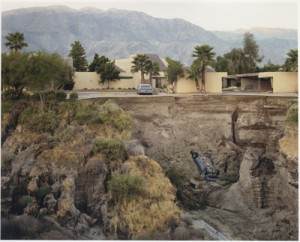« News US
Reality Check: Truth and Illusion in Contemporary Photography, at The Metropolitan Museum of Art

Joel Sternfeld (American, born 1944). After a Flash Flood, Rancho Mirage, California, July 1979, 1979, printed 2003. Chromogenic print. The Metropolitan Museum of Art, Purchase, Steven Ames, Harriet Ames Charitable Trust, and Joseph Cohen Gifts, 2004
November 4, 2008-March 22, 2009
Joyce and Robert Menschel Hall for Modern Photography
More than any other type of picture, photographs seem to have a direct and natural connection to visible reality. “Reality Check: Truth and Illusion in Contemporary Photography” surveys the ways in which artists exploit illusionism in photography to blur the distinction between what is real and what is not. Among the works featured are photographs of staged scenarios and constructed environments that appear to be real, as well as real scenes or landscapes that appear strangely artificial. On view at The Metropolitan Museum of Art from November 4, 2008, through March 22, 2009, “Reality Check” is the third installation in the Joyce and Robert Menschel Hall for Modern Photography, the Museum’s new gallery for contemporary photographs.
In recent years, artists and viewers alike have become increasingly aware of photography’s potential for distortion and ambiguity. “Reality Check” presents 30 works from the Museum’s permanent collection that tread on the fault lines between reality and artifice. With the rise of postmodernism in the 1970s, artists began to turn the assumed truthfulness of photography against itself. Taking advantage of the camera’s capacity to make scale models appear to be life-size, David Levinthal staged convincing war scenes using plastic toy soldiers, while James Casebere created haunting images of deserted interiors by photographing tabletop models of white-washed spaces, fabricated in his studio.
Set-up photography has become a major current in contemporary art, as seen in subtle and mesmerizing pictures of meticulously made replicas by Thomas Demand and Robert Gober and the elaborate cinematic scenarios of Gregory Crewdson.
While photography can make contrived scenarios look convincingly real, it can also make real scenes or landscapes appear strangely artificial. The saturated color and hallucinatory clarity of Julian Faulhaber’s pristine gas station and Frank Breuer’s sleek corporate façades have the paradoxical effect of making these real-world locales look uncannily like scale models. This play of truth and illusion becomes dazzlingly complex in photographs of places where fantasy meets reality, such as Shai Kremer’s panoramic study of a fake city used for military training. Within the last decade, the integration of photography and digital technology has pushed the medium’s trompe l’oeil illusionism to a new level. In the work of younger artists like Craig Kalpakjian, whose computer-generated images of corporate corridors have no real-world counterparts, the idea of photography as a true mirror of reality seems more illusory than ever.
Also included in the installation are photographs by Philip-Lorca diCorcia, Naoki Hanjo, Vik Muniz, Gabriel Orozco, Stephen Shore, Taryn Simon, Joel Sternfeld, Thomas Struth, Hiroshi Sugimoto, Bernard Voïta, and Mark Wyse. To provide context on the history of illusionism in photography, the contemporary works will be complemented by related photographs by James Wallace Black, James Nasmyth and James Carpenter, Edward Sheriff Curtis, and Ruth Orkin.
“Reality Check” is organized by Mia Fineman, Senior Research Associate in the Department of Photographs.
Filed Under: News US


































